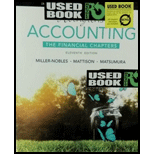
Concept explainers
Concept Introduction:
Rule of Debit and Credit
a. Debit What comes in and Credit What goes out
b. Debit is the receiver and Credit is the giver.
c. All gains and income are credit and all losses and expenses are debit.
Capital Contribution: Capital Contribution is the amount contributed by Partners in a firm. It can be in Cash or in Kind. Like Partner can bring any asset as a capital contribution.
Requirement1
To prepare: Journal Entries for capital contribution received from Kennet and Waters.
Requirement 2
To Determine: The Total Account Balances of
1. Asset of Partnership Firm
2. Liabilities of Partnership Firm
3. Partner’s Equity of Partnership Firm
Want to see the full answer?
Check out a sample textbook solution
Chapter 12 Solutions
Horngren's Accounting, The Financial Chapters (11th Edition) - Standalone Book
- I need assistance with this financial accounting problem using valid financial procedures.arrow_forwardI need assistance with this financial accounting question using appropriate principles.arrow_forwardCan you solve this general accounting problem using appropriate accounting principles?arrow_forward
- Please give me true answer this financial accounting questionarrow_forwardAccurate Answerarrow_forwardDepartment B had 12,000 units in work in process that were 75% completed as to labor and overhead at the beginning of the period; 52,400 units of direct materials were added during the period; 48,000 units were completed during the period, and 9,500 units were 60% completed as to labor and overhead at the end of the period. All materials are added at the beginning of the process. The first-in, first-out method is used to cost inventories. The number of equivalent units of production for conversion costs for the period was ____ Units.arrow_forward
- Can you help me solve this general accounting problem with the correct methodology?arrow_forwardPlease explain the correct approach for solving this general accounting question.arrow_forwardI am looking for the correct answer to this financial accounting question with appropriate explanations.arrow_forward
- Want Answerarrow_forwardPlease help me solve this general accounting question using the right accounting principles.arrow_forwardAt the beginning of the year, Anna began a calendar-year business and placed in service the following assets during the year: Asset Date Acquired Cost Basis Computers 1/30 $ 28,000 Office desks 2/15 $ 32,000 Machinery 7/25 $ 75,000 Office building 8/13 $ 400,000 Assuming Anna does not elect §179 expensing and elects not to use bonus depreciation, answer the following questions: (Use MACRS Table 1, Table 2, Table 3, Table 4 and Table 5.) Note: Do not round intermediate calculations. b. What is Anna's year 2 cost recovery for each asset?arrow_forward

 AccountingAccountingISBN:9781337272094Author:WARREN, Carl S., Reeve, James M., Duchac, Jonathan E.Publisher:Cengage Learning,
AccountingAccountingISBN:9781337272094Author:WARREN, Carl S., Reeve, James M., Duchac, Jonathan E.Publisher:Cengage Learning, Accounting Information SystemsAccountingISBN:9781337619202Author:Hall, James A.Publisher:Cengage Learning,
Accounting Information SystemsAccountingISBN:9781337619202Author:Hall, James A.Publisher:Cengage Learning, Horngren's Cost Accounting: A Managerial Emphasis...AccountingISBN:9780134475585Author:Srikant M. Datar, Madhav V. RajanPublisher:PEARSON
Horngren's Cost Accounting: A Managerial Emphasis...AccountingISBN:9780134475585Author:Srikant M. Datar, Madhav V. RajanPublisher:PEARSON Intermediate AccountingAccountingISBN:9781259722660Author:J. David Spiceland, Mark W. Nelson, Wayne M ThomasPublisher:McGraw-Hill Education
Intermediate AccountingAccountingISBN:9781259722660Author:J. David Spiceland, Mark W. Nelson, Wayne M ThomasPublisher:McGraw-Hill Education Financial and Managerial AccountingAccountingISBN:9781259726705Author:John J Wild, Ken W. Shaw, Barbara Chiappetta Fundamental Accounting PrinciplesPublisher:McGraw-Hill Education
Financial and Managerial AccountingAccountingISBN:9781259726705Author:John J Wild, Ken W. Shaw, Barbara Chiappetta Fundamental Accounting PrinciplesPublisher:McGraw-Hill Education





